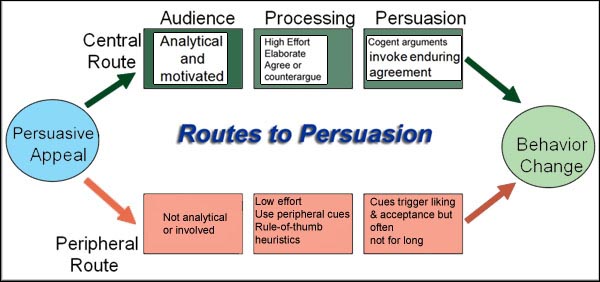|
|

|
Ψ Persuasion
|

|
|
Notes & Links for the chapter.
What paths lead to persuasion?

Central route: Build strong "central" arguments.
Peripheral route: Use simple rule of thumb heuristics, such as "trust the experts".
Ψ The Two Routes in Therapy
• The peripheral route opens the door to reason, the center route then provides a more enduring attitude & behavior change.
What are the elements of persuasion?
Ψ The communicator
• The effect of source credibility (perceived expertise &
trustworthiness) diminishes after a month or so. There is a delayed persuasion of the message content after people forget who said
it. This phenomenon is called the sleeper effect
• Physical attractiveness increases the communicator's influence &
people respond better to messages that come from an in-group member.
Ψ Robert Cialdini defines six "Weapons of Influence"
• Authority - People will tend to obey authority figures, even if they are asked to perform objectionable acts.
• Liking - People are easily persuaded by other people that they like. People were more likely to buy if they liked the person selling it to them.
• Social Proof - People will do things that they see other people are doing. e,g,, in one experiment, one or more confederates would look up into the sky; bystanders would then look up into the sky to see what they were seeing. At one point this experiment aborted, as so many people were looking up that they stopped traffic.
• Reciprocity - People tend to return a favor, thus the pervasiveness of free samples in marketing.
• Commitment & Consistency - If people commit, orally or in writing, to an idea or goal, they are more likely to honor that commitment. Even if the original incentive or motivation is removed after they have already agreed, they will continue to honor the agreement. For example, in car sales, suddenly raising the price at the last moment works because the buyer has already decided to buy.
• Scarcity - Perceived scarcity will generate demand. For example, saying offers are available for a "limited time only" encourages sales.
Ψ The Message Content (What is said?)
Reason versus Emotion
• You can marry passion & logic in a message to target all the audience.
• Well educated, analytical, thoughtful, involved audiences travel the central route
of persuasion. Disinterested audiences follow the peripheral route, & are
more affected by how well they like the communicator.
The effects of good feelings:
• Good feeling enhance persuasion! - partly by
increasing positive thinking &
partly by linking good feelings with the message.
The effects of arousing fear:
• By evoking negative emotions, a fear arousing message can be potent.
Discrepancy
• credible sources can advocate larger discrepancies more effectively
• lower discrepancy tolerable to involved audience
One-sided versus two-sided appeals
• effect of audience agreement (1-sided better if audience already agrees; 2-sided
better if audience disagrees)
• awareness of counter-arguments
• (If the audience will hear the other side anyhow, you should use a 2-sided appeal.)
• emphasize positive effects for optimists, negative effects for pessimists
Primacy versus recency
• primacy effect: early information is most persuasive
• recency effect: later information is most persuasive if it immediately precedes the decision, especially if the other side was presented much earlier
Ψ The Channel of communication (How is it said?)
• Active experience or passive reception? Go active!
• Personal versus media influence - Personal
trumps media.
• two-step flow of communication (media to opinion leaders to everyday people)
• Media: more effective for simple messages; writing for complex ones.
Ψ The Audience (To whom is it said)
How old are they?
People tend to have different social & political attitudes depending on their age,
• Life cycle explanation: Attitudes change e.g. become more
conservative,
as people grow older.
• Generational explanation: The attitudes
older people adopted when they were
young persist largely unchanged; because young people adopt different attitudes
now, a generation gap develops. This
explanation is strongly supported by the
research.
Is
their thinking favorable or not?
Forewarned is forearmed - if you care enough to
counter argue.
Distraction disarms
counter arguing.
Ψ Uninvolved audiences use peripheral cues.
• Ways to stimulate thinking:
• rhetorical questions
• multiple speakers
• make audience feel responsible
• relaxed postures
• repeat the message
• get undistracted attention
• Effects of thinking:
• Makes strong messages more effective
• Makes weak messages less effective (due to counter-arguing)
Extreme persuasion: How do cults indoctrinate?
Ψ In religion & sociology, a cult is a cohesive group of people (often a relatively small & recently founded new religious movement) devoted to beliefs or practices that the surrounding culture or society considers to be far outside the mainstream. Its separate status may come about either due to its novel belief system, because of its idiosyncratic practices or because it opposes the interests of the mainstream culture. Other non-religious groups may also display cult-like characteristics.
Ψ In common usage, "cult" has a negative connotation, & is generally applied to a group by its opponents.
Ψ A cult is not a sect. A sect is a religious body that has separated from a larger denomination.
Ψ Cult Indoctrination - attitudes follow behavior.
• Compliance breeds acceptance. People usually internalize commitments made voluntarily, publicly, & repeatedly. Cult leaders know this and immediately move to strengthen the
new members commitment to the cult.
• Cult recruitment strategy exploits the foot in the door phenomenon.
Ψ Cult Indoctrination - Persuasive Elements.
• The Communicator:
Successful cults have charismatic Leaders. Charismatic leaders are thought to possess such qualities such as being visionary, energetic, & unconventional as well as having outstanding rhetorical ability. The Charismatic Leader gathers followers through dint of personality & charm, rather than any form of external power or authority.
• The Message: The vivid, emotional message, & the warmth & acceptance that the Cult showers on lonely & depressed people is awesomely effective.
• The Audience:
Recruits are often young people, under 25 (before attitudes & values stabilize). Most are educated, middle class people who are seeking answers that will make them happy.
Ψ Cult Indoctrination - Group Effects:
• Increasing behavior commitment
• persuasion
• group isolation
• "Love bombing"
• Cult influence techniques are similar to techniques used by socially approved groups like fraternities, sororities & self help groups. A thin line exists between education & indoctrination, enlightenment & propaganda, therapy & mind control, and between conversion & coercion.
• Persuasion is not intrinsically bad!.
Ψ Cult Inoculation - Resisting Persuasion:
• Stimulate Commitment - Before encountering others' arguments, make a
public commitment to your position.
• Warn the receiver of the impending attack.
• Attitude Inoculation: make a weak attack, so that when stronger attacks come,
a defense will already be established.
• Get the receiver to actively defend the attitude. Develop counter arguments.
Ψ Cult Inoculation - Implications:
• The way to build resistance to brainwashing isn't to strengthen one's
current beliefs.
• Educate people about cults
to prepare then to counter
persuasive appeals.
• Ineffective persuasion, by stimulating the
listeners' defenses, may be
counterproductive. An infective appeal can be worse than none.
• Be an active listener, & a critical thinker, force yourself to counter argue.
Don't just listen react!
•
Analyze! If a message cannot withstand careful analysis, it will fail to
convince
you. You will be
inoculated!
Social Psychology
Robert C. Gates
|

|
|
 Let no pleasure tempt thee, no profit allure thee, no persuasion move thee, to do anything which thou knowest to be evil; so shalt thou always live jollity; for a good conscience is a continual Christmas. Let no pleasure tempt thee, no profit allure thee, no persuasion move thee, to do anything which thou knowest to be evil; so shalt thou always live jollity; for a good conscience is a continual Christmas.
- Benjamin Franklin
|
|





































